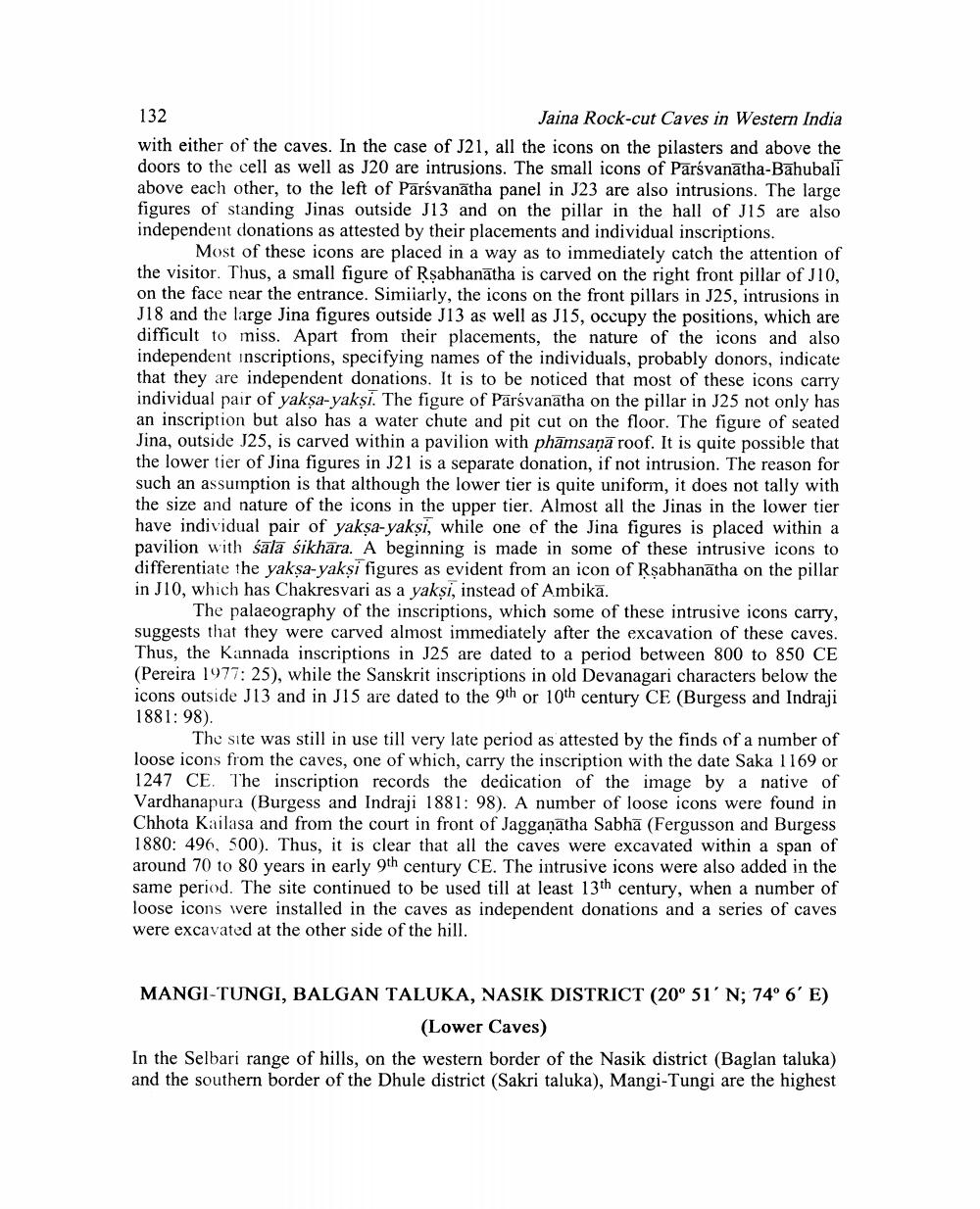________________
132
Jaina Rock-cut Caves in Western India with either of the caves. In the case of J21, all the icons on the pilasters and above the doors to the cell as well as J20 are intrusions. The small icons of Parsvanatha-Bāhubali above each other, to the left of Parsvanatha panel in J23 are also intrusions. The large figures of standing Jinas outside J13 and on the pillar in the hall of J15 are also independent donations as attested by their placements and individual inscriptions.
Most of these icons are placed in a way as to immediately catch the attention of the visitor. Thus, a small figure of Rsabhanatha is carved on the right front pillar of J10, on the face near the entrance. Similarly, the icons on the front pillars in J25, intrusions in J18 and the large Jina figures outside J13 as well as J15, occupy the positions, which are difficult to miss. Apart from their placements, the nature of the icons and also independent inscriptions, specifying names of the individuals, probably donors, indicate that they are independent donations. It is to be noticed that most of these icons carry individual pair of yakṣa-yakṣi. The figure of Parsvanatha on the pillar in J25 not only has an inscription but also has a water chute and pit cut on the floor. The figure of seated Jina, outside J25, is carved within a pavilion with phamsaṇā roof. It is quite possible that the lower tier of Jina figures in J21 is a separate donation, if not intrusion. The reason for such an assumption is that although the lower tier is quite uniform, it does not tally with the size and nature of the icons in the upper tier. Almost all the Jinas in the lower tier have individual pair of yakṣa-yakṣi, while one of the Jina figures is placed within a pavilion with salā śikhāra. A beginning is made in some of these intrusive icons to differentiate the yaksa-yaksi figures as evident from an icon of Rṣabhanatha on the pillar in J10, which has Chakresvari as a yakşi, instead of Ambikā.
The palaeography of the inscriptions, which some of these intrusive icons carry, suggests that they were carved almost immediately after the excavation of these caves. Thus, the Kannada inscriptions in J25 are dated to a period between 800 to 850 CE (Pereira 1977: 25), while the Sanskrit inscriptions in old Devanagari characters below the icons outside J13 and in J15 are dated to the 9th or 10th century CE (Burgess and Indraji 1881:98).
The site was still in use till very late period as attested by the finds of a number of loose icons from the caves, one of which, carry the inscription with the date Saka 1169 or 1247 CE. The inscription records the dedication of the image by a native of Vardhanapura (Burgess and Indraji 1881: 98). A number of loose icons were found in Chhota Kailasa and from the court in front of Jagganatha Sabha (Fergusson and Burgess 1880: 496, 500). Thus, it is clear that all the caves were excavated within a span of around 70 to 80 years in early 9th century CE. The intrusive icons were also added in the same period. The site continued to be used till at least 13th century, when a number of loose icons were installed in the caves as independent donations and a series of caves were excavated at the other side of the hill.
MANGI-TUNGI, BALGAN TALUKA, NASIK DISTRICT (20° 51′ N; 74° 6' E)
(Lower Caves)
In the Selbari range of hills, on the western border of the Nasik district (Baglan taluka) and the southern border of the Dhule district (Sakri taluka), Mangi-Tungi are the highest




